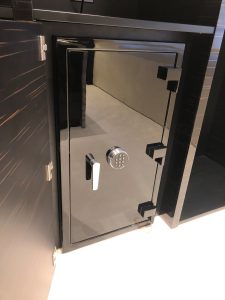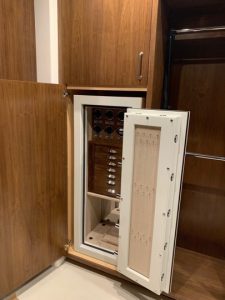Tips for buying a jewelry safe
Finding the right safe for your precious items
What do To Catch a Thief, The Thomas Crown Affair (1968) and Ocean’s 8 have in common? They are all films about a jewelry heist. Even the earliest known black and white cinematic thriller — the silent French film Fantômas (1913) —featured a thief who steals jewelry from a wealthy woman’s home. While providing thrills and chills on the screen, we all want to avoid such real-life dramas.
This article is concerned with protecting your valuable adornments at your residence, and one of the best ways to help protect your jewelry and watches is with a holistic approach involving home security systems coupled with a permanent safe that is embedded into the floor or a wall.
Tip: See our separate blog on traveling safely with your jewelry here.
When safeguarding your home and the valuables in it, high quality safe can be a vital component of safeguarding your valuables and protecting the perimeter and placement of your safe are equally important.
Delay entry
Homes without security systems are 300% more likely to be broken into, but only 25% of American have a home security system, according to FBI statistics.1 An excellent exterior security system can both deter and delay a thief’s entry. “A layered approach is best when it comes to home security,” states Cletus Nunes, President of Casoro Jewelry Safes and Maximum Security Safes.

Pictured: a Casoro black safe
“The most effective protection includes a high-security safe with burglary and fire protection, bolted to the floor, and hardwired to a separate zone of the home alarm system. We call this integrated security. Although Wi-Fi connections are convenient, they can be jammed by burglars, creating vulnerabilities.”
Another important issue is that people who live in gated communities or doorman buildings are not exempt from a thief’s targeted focus. Nunes elaborates, “What do Travis Kelce and Patrick Mahomes (Kansas City Chiefs), Luka Doncic (Dallas Mavericks), and Mike Conley (MN Timberwolves) have in common? These sports stars were all burglarized in their gated community homes. So don’t be lulled into a false sense of security because your community is gated.”
No typical treasure maps
Some people tend to keep their valuable jewelry and watches where they sleep or brush their teeth, and that is exactly where the thief is headed. Consider installing a secure safe in a location away from the master bedroom or bathroom or having multiple safes in your home. Ideally, the location of the safe should not be visible to household staff or visitors to the home.
Amanda McComas, Berkley One’s Vice President of Risk Management notes,
“Studies show that 65% of burglars know their victims (according to the FBI’s Uniform Crime Reporting Program).
So anyone who has access to the home can then become the person who focuses on the home. This could be the plumber, housekeeper, or anyone working on your home. Keeping valuables hidden and out of sight makes others unaware of your valuables.”
Home Safe Considerations
Thieves breaking into a home often have a very limited amount of time. Portable safes can be easily removed and carried out of the home. Using a high-quality embedded safe may make the intruder’s work take more time, which may deter them. While the peril of theft is real, Casoro’s Nunes notes that the outcomes of other perils, like fire and water, are also a valid concern.
When considering a home safe, consider factors like:
- The size and number of the items you need to store – also anticipate future acquisitions
- Occupancy of the residency
- Type of locking mechanism (dial combination, electronic, or biometric)
- Fire resistance rating
- UL rating (Underwriting Laboratory)
- Location for safe installation
- Water resistance – if needed
- Weight of the safe
- for deterring theft
- impact on location – floors and stairwells often have different weight bearing loads
Some insurance companies have a requirement for the quality of the safes used to protect jewelry, high-end watches, and other high valued insurable items.

Pictured: A Casoro cream safe
A TL-15 rating is the benchmark. The TL stands for Tool Resistance, and 15 isthe number of minutes the safe should be able to withstand an attack with tools used to try and pierce its exterior. The fire rating usually refers to the number of hours the safe can withstand a fire. The assumption is: the heavier the safe, the better the TL rating and fire resistance rating. Regarding the locking mechanisms, Berkley One’s McComas observes, “We’re seeing an uptick in the use of biometric safes (usually in the form of retina or fingerprint scanning). These locks can also be faster to access in an emergency, without the need to have a key or remember a code.”
In general, it’s important to consider what you want to protect and the pros and cons of the type of security you are looking for.
Resources:
Although off-the shelf safe options are available, many homeowners are seeking customized options that combine function and security with décor and style. Security professionals can also advise you on considerations and possible solutions for your needs. These are some of the companies that offer options for custom made or pre-configured models with high UL and fire protection ratings.
Casoro Safes
Brown Safe
Safe & Vault Store
–
Berkley One is a Berkley Company.



